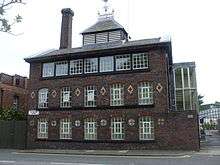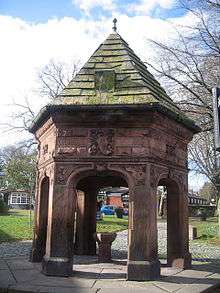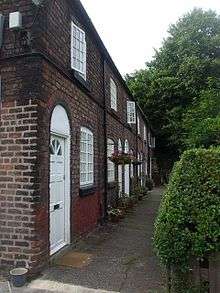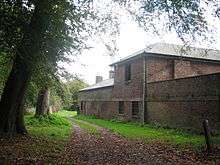Grade II listed buildings in Liverpool-L25
| Listed buildings in Liverpool | |
|---|---|
| Grade I listed buildings | |
| Grade II* listed buildings | |
| Grade II listed buildings: | |
Liverpool is a city and port in Merseyside, England, which contains many listed buildings. A listed building is a structure designated by English Heritage of being of architectural and/or of historical importance and, as such, is included in the National Heritage List for England. There are three grades of listing, according to the degree of importance of the structure. Grade I includes those buildings that are of "exceptional interest, sometimes considered to be internationally important"; the buildings in Grade II* are "particularly important buildings of more than special interest"; and those in Grade II are "nationally important and of special interest". Very few buildings are included in Grade I — only 2.5% of the total. Grade II* buildings represent 5.5% of the total, while the great majority, 92%, are included in Grade II.[1]
Liverpool contains more than 1,550 listed buildings, of which 28 are in Grade I, 109 in Grade II*, and the rest in Grade II.[lower-alpha 1] This list contains the Grade II listed buildings in the L25 postal district of Liverpool. The district includes the former villages of Woolton and Gateacre, which were later incorporated in to the growing city of Liverpool. It also contains the newer districts of Belle Vale and Hunt's Cross. The listed buildings reflect this history. They include such village features as crosses and memorials. The houses vary from small old cottages and houses, to mansions built by wealthy businessmen during the 19th century.
Grade II listed buildings from other areas in the city can be found through the template on the right, along with the lists of the Grade I and Grade II* buildings in the city.
Buildings
|
.jpg) Woolton Library, Allerton Road Beaconsfield House, Beaconsfield Road  Belle Vale Road  Church Cottages, Belle Vale Road, Gateacre .jpg) Church Road, Woolton  Reynold's Lodge, Church Road  Clegg's Factory, Gateacre Brow  Drinking fountain, Gateacre Brow  Jubilee Memorial, Gateacre Brow  Paradise Row, Grange Lane  York Cottages, Grange Lane  Camp Hill Lodge, Hillfoot Road  Quarry Street, Woolton  Water Tower, Reservoir Road  Dining hall, Much Woolton School, St Mary's Street  Gate piers and lodge, Allerton Tower  Outbuildings at Allerton Tower  Orangery, Allerton Tower .jpg) Elephant Public House, Woolton Street  Street lamp, Woolton |
See also
References and notes
Notes
- ↑ These figures are taken from a search in the National Heritage List for England in May 2013, and are subject to variation as further buildings are listed, grades are revised, or buildings are delisted.
Citations
- ↑ Listed Buildings, Historic England, retrieved 25 March 2015
- ↑ Historic England, "Acrefield Cottage, Liverpool (1280861)", National Heritage List for England, retrieved 16 October 2013
- ↑ Historic England, "Acrefield Kindergarten, Liverpool (1205127)", National Heritage List for England, retrieved 5 October 2013
- ↑ Pollard & Pevsner (2006), pp. 512–513
- ↑ Historic England, "Aymestrey Court Hostel, Liverpool (1280884)", National Heritage List for England, retrieved 16 October 2013
- ↑ Liverpool: Woolton, Aymestrey Court Boarding Special School for Maladjusted Boys, National Archives, retrieved 16 October 2013
- ↑ Aymestrey Court to be restored, Gateacre Society, May 2008, retrieved 16 October 2013
- 1 2 3 4 5 Pollard & Pevsner (2006), p. 513
- ↑ Historic England, "The Coach-house at Aymestrey Court Hostel, Liverpool (1356240)", National Heritage List for England, retrieved 18 October 2013
- 1 2 3 4 5 6 7 8 Pollard & Pevsner (2006), p. 512
- ↑ Historic England, "Bankside, Liverpool (1205122)", National Heritage List for England, retrieved 5 October 2013
- ↑ Historic England, "Blair Lea Lodge, Liverpool (1068438)", National Heritage List for England, retrieved 3 October 2013
- ↑ Historic England, "Hillcliffe, Liverpool (1068442)", National Heritage List for England, retrieved 3 October 2013
- ↑ Historic England, "The Lodge to Aymestrey Court Hostel, Liverpool (1068439)", National Heritage List for England, retrieved 3 October 2013
- ↑ Historic England, "The Mount, Liverpool (1068441)", National Heritage List for England, retrieved 3 October 2013
- ↑ Historic England, "8 and 10 Acrefield Road, Liverpool (1205118)", National Heritage List for England, retrieved 5 October 2013
- ↑ Historic England, "12 and 14 Acrefield Road, Liverpool (1068440)", National Heritage List for England, retrieved 3 October 2013
- ↑ Historic England, "16 Acrefield Road, Liverpool (1205119)", National Heritage List for England, retrieved 5 October 2013
- ↑ Historic England, "18 and 20 Acrefield Road, Liverpool (1356241)", National Heritage List for England, retrieved 18 October 2013
- 1 2 Pollard & Pevsner (2006), p. 390
- ↑ Historic England, "Allerton Golf Club House, Liverpool (1205208)", National Heritage List for England, retrieved 5 October 2013
- ↑ Historic England, "Obelisk on lawn to south east of Allerton Golf Club House, Liverpool (1356268)", National Heritage List for England, retrieved 18 October 2013
- 1 2 3 Pollard & Pevsner (2006), p. 391
- ↑ Historic England, "Lodge to Allerton Priory, Liverpool (1205220)", National Heritage List for England, retrieved 5 October 2013
- 1 2 3 Pollard & Pevsner (2006), p. 511
- ↑ Historic England, "Woolton Library, Liverpool (1356271)", National Heritage List for England, retrieved 18 October 2013
- ↑ Historic England, "25 Allerton Road, Liverpool (1068417)", National Heritage List for England, retrieved 3 October 2013
- ↑ Historic England, "Lake House, Liverpool (1356270)", National Heritage List for England, retrieved 18 October 2013
- ↑ Historic England, "30 Allerton Road, Liverpool (1068418)", National Heritage List for England, retrieved 3 October 2013
- ↑ Historic England, "61 and 61A Allerton Road, Liverpool (1280832)", National Heritage List for England, retrieved 15 October 2013
- ↑ Historic England, "82–86 Allerton Road, Liverpool (1205248)", National Heritage List for England, retrieved 5 October 2013
- ↑ Historic England, "104 and 106 Allerton Road, Liverpool (1205249)", National Heritage List for England, retrieved 5 October 2013
- ↑ Historic England, "116 and 118 Allerton Road, Liverpool (1068419)", National Heritage List for England, retrieved 3 October 2013
- ↑ Historic England, "120 Allerton Road, Liverpool (1205251)", National Heritage List for England, retrieved 5 October 2013
- ↑ Historic England, "1–6 Ashton Square, Liverpool (1205344)", National Heritage List for England, retrieved 5 October 2013
- ↑ Historic England, "7 Ashton Square, Liverpool (1068395)", National Heritage List for England, retrieved 3 October 2013
- 1 2 3 4 5 6 Pollard & Pevsner (2006), p. 514
- ↑ Historic England, "Abbots Lea (original mansion only), Liverpool (1280721)", National Heritage List for England, retrieved 15 October 2013
- ↑ Historic England, "Beacon Hill, Liverpool (1068398)", National Heritage List for England, retrieved 3 October 2013
- ↑ Pollard & Pevsner (2006), pp. 513–514
- ↑ Historic England, "Knolle Park (Saint Gabriel's Convent), Liverpool (1356262)", National Heritage List for England, retrieved 18 October 2013
- ↑ Waddington, Marc (25 October 2012), "Major 'care village' planned for former Liverpool children's home in Woolton", Liverpool Echo, retrieved 18 October 2013
- ↑ Historic England, "Entrance to Knolle Park, Liverpool (1068367)", National Heritage List for England, retrieved 3 October 2013
- ↑ Historic England, "Lodge to Knolle Park, Liverpool (1280728)", National Heritage List for England, retrieved 15 October 2013
- ↑ Historic England, "The Cottage and Beaconsfield, Liverpool (1356261)", National Heritage List for England, retrieved 18 October 2013
- ↑ Historic England, "Stoneleigh, Liverpool (1068399)", National Heritage List for England, retrieved 3 October 2013
- ↑ Historic England, "Beaconsfield House, Liverpool (1205407)", National Heritage List for England, retrieved 5 October 2013
- ↑ Historic England, "1–4 Church Cottages, Belle Vale Road, Liverpool (1205546)", National Heritage List for England, retrieved 5 October 2013
- ↑ Historic England, "5–8 Church Cottages, Belle Vale Road, Liverpool (1068376)", National Heritage List for England, retrieved 3 October 2013
- ↑ Historic England, "9–12 Church Cottages, Belle Vale Road, Liverpool (1356290)", National Heritage List for England, retrieved 19 October 2013
- ↑ Pollard & Pevsner (2006), pp. 431–432
- ↑ Historic England, "Church of St Stephen, Liverpool (1356289)", National Heritage List for England, retrieved 20 October 2013
- ↑ Historic England, "Signpost opposite No.66 Belle Vale Road, Liverpool (1280675)", National Heritage List for England, retrieved 15 October 2013
- ↑ Historic England, "1 and 2 Belle Vale Road and front garden wall, Liverpool (1068374)", National Heritage List for England, retrieved 3 October 2013
- ↑ Historic England, "3 and 4 Belle Vale Road and front garden wall, Liverpool (1205536)", National Heritage List for England, retrieved 5 October 2013
- ↑ Historic England, "5, 6 and 7 Belle Vale Road and front garden wall, Liverpool (1068375)", National Heritage List for England, retrieved 3 October 2013
- ↑ Historic England, "8 and 9 Belle Vale Road and front garden wall, Liverpool (1280671)", National Heritage List for England, retrieved 15 October 2013
- ↑ Pollard & Pevsner (2006), pp. 511–512
- ↑ Historic England, "Archbishop's House (Roman Catholic), Liverpool (1356326)", National Heritage List for England, retrieved 19 October 2013
- ↑ Historic England, "Boundary Stone on south side of Reservoir Road junction, Liverpool (1068329)", National Heritage List for England, retrieved 3 October 2013
- ↑ Historic England, "Churchfield, Liverpool (1068292)", National Heritage List for England, retrieved 3 October 2013
- 1 2 3 Pollard & Pevsner (2006), p. 507
- ↑ Historic England, "Lych gate to St. Peter's Church, Liverpool (1068328)", National Heritage List for England, retrieved 3 October 2013
- ↑ Historic England, "Outbuilding, Church Road, Liverpool (1068293)", National Heritage List for England, retrieved 3 October 2013
- ↑ Historic England, "Reynolds Lodge, Liverpool (1068294)", National Heritage List for England, retrieved 3 October 2013
- ↑ Historic England, "Riffle Lodge, Liverpool (1356327)", National Heritage List for England, retrieved 19 October 2013
- ↑ Historic England, "Rosemont, Liverpool (1280354)", National Heritage List for England, retrieved 15 October 2013
- ↑ Historic England, "Roman Catholic Church of Saint Mary, Liverpool (1280345)", National Heritage List for England, retrieved 15 October 2013
- ↑ Historic England, "Presbytery of St. Mary's Church, Liverpool (1356302)", National Heritage List for England, retrieved 19 October 2013
- ↑ Historic England, "St. Peters Parish Rooms and office, Liverpool (1068290)", National Heritage List for England, retrieved 3 October 2013
- ↑ Historic England, "Yewfield, Liverpool (1068291)", National Heritage List for England, retrieved 3 October 2013
- ↑ Historic England, "Knolle Park Mews, Liverpool (1356303)", National Heritage List for England, retrieved 19 October 2013
- ↑ Historic England, "2, 4, 6, 8, and 8A Church Road, Woolton, Liverpool (1206183)", National Heritage List for England, retrieved 5 October 2013
- ↑ Historic England, "7–19 Church Road, Woolton, Liverpool (1280380)", National Heritage List for England, retrieved 15 October 2013
- ↑ Historic England, "10 and 12 Church Road, Woolton, Liverpool (1068330)", National Heritage List for England, retrieved 3 October 2013
- ↑ Historic England, "14–22 Church Road, Woolton, Liverpool (1356324)", National Heritage List for England, retrieved 19 October 2013
- ↑ Historic England, "21 and 23 Church Road, Woolton, Liverpool (1356301)", National Heritage List for England, retrieved 19 October 2013
- ↑ Historic England, "24 Church Road, Woolton, Liverpool (1068289)", National Heritage List for England, retrieved 3 October 2013
- ↑ Historic England, "26 Church Road, Woolton, Liverpool (1356325)", National Heritage List for England, retrieved 19 October 2013
- ↑ Historic England, "25 and 27 Church Road, Woolton, Liverpool (1068327)", National Heritage List for England, retrieved 3 October 2013
- ↑ Historic England, "The Cottage, Clarke's Gardens, Liverpool (1206224)", National Heritage List for England, retrieved 5 October 2013
- ↑ Historic England, "Oakfield Terrace, Liverpool (1068272)", National Heritage List for England, retrieved 2 October 2013
- ↑ Historic England, "The Black Bull Public House, Liverpool (1025015)", National Heritage List for England, retrieved 1 October 2013
- 1 2 3 4 5 6 7 8 9 10 Pollard & Pevsner (2006), p. 432
- ↑ Historic England, "Drinking fountain, Gateacre Brow, Liverpool (1068218)", National Heritage List for England, retrieved 2 October 2013
- ↑ Historic England, "Clegg's Factory Building, Liverpool (1356369)", National Heritage List for England, retrieved 19 October 2013
- ↑ Historic England, "Jubilee memorial, Gateacre Brow, Liverpool (1068219)", National Heritage List for England, retrieved 2 October 2013
- ↑ Pollard & Pevsner (2006), p. 431
- ↑ Historic England, "Unitarian chapel, Gateacre Brow, Liverpool (1356368)", National Heritage List for England, retrieved 19 October 2013
- ↑ Historic England, "2 Gateacre Brow, Liverpool (1024988)", National Heritage List for England, retrieved 1 October 2013
- ↑ Historic England, "4 Gateacre Brow, Liverpool (1356367)", National Heritage List for England, retrieved 19 October 2013
- ↑ Historic England, "6 Gateacre Brow, Liverpool (1355190)", National Heritage List for England, retrieved 18 October 2013
- ↑ Historic England, "8 Gateacre Brow, Liverpool (1068220)", National Heritage List for England, retrieved 1 October 2013
- ↑ Historic England, "10 and 12 Gateacre Brow, Liverpool (1024998)", National Heritage List for England, retrieved 3 October 2013
- ↑ Historic England, "28A, 28B, 28C, and 28D Gateacre Brow, Liverpool (1187200)", National Heritage List for England, retrieved 4 October 2013
- ↑ Historic England, "34 Gateacre Brow, Liverpool (1068221)", National Heritage List for England, retrieved 1 October 2013
- ↑ Historic England, "38 and 40 Gateacre Brow, Liverpool (1068222)", National Heritage List for England, retrieved 1 October 2013
- ↑ Historic England, "42 Gateacre Brow, Liverpool (1187210)", National Heritage List for England, retrieved 4 October 2013
- ↑ Historic England, "Strawberry House, Mossdene and Crawfordsburn, Liverpool (1356371)", National Heritage List for England, retrieved 20 October 2013
- ↑ Historic England, "The Crying Tree, Liverpool (1356372)", National Heritage List for England, retrieved 20 October 2013
- ↑ Historic England, "Grange Hollies, Liverpool (1052236)", National Heritage List for England, retrieved 1 October 2013
- ↑ The Hollies, Abbeyfield, retrieved 1 October 2013
- 1 2 Pollard & Pevsner (2006), p. 433
- ↑ Historic England, "Grange Lodge, Liverpool (1068227)", National Heritage List for England, retrieved 2 October 2013
- ↑ Historic England, "The Cottage, Grange Mews and Riding School House, Liverpool (1052247)", National Heritage List for England, retrieved 1 October 2013
- ↑ Historic England, "2 and 3 Paradise Row, Liverpool (1068228)", National Heritage List for England, retrieved 2 October 2013
- ↑ Historic England, "4 and 5 Paradise Row, Liverpool (1356373)", National Heritage List for England, retrieved 20 October 2013
- ↑ Pollard & Pevsner (2006), pp. 432–433
- ↑ Historic England, "1–4 Soarer Cottages, Liverpool (1372321)", National Heritage List for England, retrieved 20 October 2013
- ↑ Historic England, "1–7 York Cottages, Grange Lane, Liverpool (1068229)", National Heritage List for England, retrieved 2 October 2013
- ↑ Historic England, "8–14 York Cottages, Grange Lane, Liverpool (1372308)", National Heritage List for England, retrieved 20 October 2013
- ↑ Historic England, "Gateway to Gateacre Hall Hotel, Liverpool (1075207)", National Heritage List for England, retrieved 4 October 2013
- ↑ Historic England, "Kingsley, Liverpool (1075206)", National Heritage List for England, retrieved 4 October 2013
- ↑ Historic England, "5-9 Halewood Road, Liverpool (1075205)", National Heritage List for England, retrieved 4 October 2013
- ↑ Historic England, "78 and 80 Halewood Road, Liverpool (1187365)", National Heritage List for England, retrieved 4 October 2013
- ↑ Historic England, "Camp Hill Lodge, Liverpool (1075182)", National Heritage List for England, retrieved 4 October 2013
- ↑ Historic England, "1 Mason Street, Liverpool (1070632)", National Heritage List for England, retrieved 3 October 2013
- ↑ Historic England, "Fletchers Farmhouse, Liverpool (1293230)", National Heritage List for England, retrieved 18 October 2013
- ↑ Pollard & Pevsner (2006), pp. 507–508
- ↑ Historic England, "Much Woolton Roman Catholic School, Liverpool (1208470)", National Heritage List for England, retrieved 13 October 2013
- ↑ Historic England, "Newstead Farmhouse with attached buildings, Liverpool (1072974)", National Heritage List for England, retrieved 3 October 2013
- ↑ Historic England, "2–8 Quarry Street, Liverpool (1209018)", National Heritage List for England, retrieved 3 October 2013
- ↑ Historic England, "10, 12 and 14 Quarry Street, Liverpool (1292859)", National Heritage List for England, retrieved 18 October 2013
- ↑ Historic England, "65 and 67 Quarry Street, Liverpool (1365825)", National Heritage List for England, retrieved 20 October 2013
- ↑ Historic England, "69–75 Quarry Street, Liverpool (1209016)", National Heritage List for England, retrieved 13 October 2013
- ↑ Historic England, "81–87 Quarry Street, Liverpool (1072973)", National Heritage List for England, retrieved 3 October 2013
- ↑ Historic England, "Water Tower, Liverpool (1072943)", National Heritage List for England, retrieved 3 October 2013
- ↑ Pollard & Pevsner (2006), pp. 433–434
- ↑ Historic England, "Gateacre Grange, Liverpool (1209737)", National Heritage List for England, retrieved 13 October 2013
- 1 2 3 4 5 Pollard & Pevsner (2006), p. 434
- ↑ Historic England, "House to north of Gateacre Grange and belonging to it, Liverpool (1073492)", National Heritage List for England, retrieved 4 October 2013
- ↑ Historic England, "Lodge and stable block to Gateacre Grange, Liverpool (1073493)", National Heritage List for England, retrieved 4 October 2013
- ↑ Historic England, "Rose Cottage, Liverpool (1073491)", National Heritage List for England, retrieved 4 October 2013
- ↑ Historic England, "1–5 Rose Brow, Liverpool (1361654)", National Heritage List for England, retrieved 20 October 2013
- ↑ Historic England, "Golf Lodge, Liverpool (1210077)", National Heritage List for England, retrieved 13 October 2013
- ↑ Historic England, "Dining Hall of Much Woolton R.C. school, Liverpool (1361685)", National Heritage List for England, retrieved 20 October 2013
- ↑ Historic England, "Hunt's Cross, Liverpool (1063326)", National Heritage List for England, retrieved 1 October 2013
- ↑ Historic England, "Hunts Cross Station (Incorporating Stationmaster's House), Liverpool (1217957)", National Heritage List for England, retrieved 13 October 2013
- ↑ Historic England, "Village Cross at junction with Speke Road, Liverpool (1063756)", National Heritage List for England, retrieved 1 October 2013
- ↑ Historic England, "Woolton Hall Lodge, Liverpool (1359839)", National Heritage List for England, retrieved 20 October 2013
- ↑ Historic England, "Oak Farmhouse, Liverpool (1217968)", National Heritage List for England, retrieved 13 October 2013
- ↑ Historic England, "Woolton Tower, Tower House, and Towers Cottage, Liverpool (1218179)", National Heritage List for England, retrieved 13 October 2013
- ↑ Historic England, "Gateway to Woolton Hall Park, Liverpool (1063788)", National Heritage List for England, retrieved 2 October 2013
- ↑ Historic England, "Woodleigh (former Lodge to Woolton Hall), Liverpool (1218687)", National Heritage List for England, retrieved 13 October 2013
- ↑ Pollard & Pevsner (2006), pp. 508–509
- ↑ Historic England, "Woolton Manor, Liverpool (1218690)", National Heritage List for England, retrieved 13 October 2013
- ↑ Historic England, "2A Woolton High Street, Liverpool (1359625)", National Heritage List for England, retrieved 20 October 2013
- ↑ Historic England, "2–6 Woolton High Street, Liverpool (1291822)", National Heritage List for England, retrieved 17 October 2013
- ↑ Historic England, "8 Woolton High Street, Liverpool (1063789)", National Heritage List for England, retrieved 2 October 2013
- ↑ Historic England, "10 Woolton High Street, Liverpool (1359648)", National Heritage List for England, retrieved 20 October 2013
- ↑ Historic England, "12 Woolton High Street, Liverpool (1063746)", National Heritage List for England, retrieved 1 October 2013
- ↑ Historic England, "14 and 16 Woolton High Street, Liverpool (1291825)", National Heritage List for England, retrieved 17 October 2013
- ↑ Historic England, "20–28 Woolton High Street, Liverpool (1063747)", National Heritage List for England, retrieved 1 October 2013
- ↑ Historic England, "30 and 32 Woolton High Street, Liverpool (1291827)", National Heritage List for England, retrieved 17 October 2013
- ↑ Historic England, "Cliff Cottage, Liverpool (1359649)", National Heritage List for England, retrieved 20 October 2013
- ↑ Historic England, "North gate piers to Allerton Hall with connecting walls and railings, Liverpool (1218747)", National Heritage List for England, retrieved 14 October 2013
- ↑ Historic England, "Laundry and stables at Allerton Tower, Liverpool (1359651)", National Heritage List for England, retrieved 20 October 2013
- ↑ Historic England, "Lodge to Allerton Tower, with adjoining gate piers, Liverpool (1291836)", National Heritage List for England, retrieved 18 October 2013
- ↑ Historic England, "Allerton Tower Orangery, Liverpool (1218738)", National Heritage List for England, retrieved 14 October 2013
- ↑ Pollard & Pevsner (2006), p. 392
- ↑ Historic England, "Springwood Lodge, Liverpool (1218740)", National Heritage List for England, retrieved 14 October 2013
- ↑ Pollard & Pevsner (2006), pp. 391–392
- ↑ Historic England, "Springwood House, Liverpool (1063750)", National Heritage List for England, retrieved 1 October 2013
- ↑ Historic England, "Corporation offices, Liverpool (1291813)", National Heritage List for England, retrieved 17 October 2013
- ↑ Historic England, "Elephant Hotel and Restaurant, Liverpool (1063754)", National Heritage List for England, retrieved 1 October 2013
- ↑ Historic England, "Street lamp at junction with Allerton Road, Liverpool (1291804)", National Heritage List for England, retrieved 17 October 2013
- ↑ Historic England, "Greenbank, Liverpool (1063752)", National Heritage List for England, retrieved 1 October 2013
- ↑ Historic England, "4 and 6 Woolton Street, Liverpool (1063753)", National Heritage List for England, retrieved 3 October 2013
- ↑ Historic England, "Stable block to 4 and 6 Woolton Street, Liverpool (1218749)", National Heritage List for England, retrieved 14 October 2013
- ↑ Historic England, "Former farm building to rear of no. 25 Woolton Street, Liverpool (1291809)", National Heritage List for England, retrieved 17 October 2013
- ↑ Historic England, "Salisbury Farm Dairy, Liverpool (1063755)", National Heritage List for England, retrieved 1 October 2013
- ↑ Historic England, "35 Woolton Street, Liverpool (1063757)", National Heritage List for England, retrieved 1 October 2013
- ↑ Historic England, "35A Woolton Street, Liverpool (1063758)", National Heritage List for England, retrieved 1 October 2013
- ↑ Historic England, "37 Woolton Street, Liverpool (1291816)", National Heritage List for England, retrieved 17 October 2013
- ↑ Historic England, "39, 41 and 43 Woolton Street, Liverpool (1063759)", National Heritage List for England, retrieved 2 October 2013
- ↑ Historic England, "45 and 47 Woolton Street, Liverpool (1291778)", National Heritage List for England, retrieved 17 October 2013
- ↑ Historic England, "The Old House, 49 Woolton Street, Liverpool (1359652)", National Heritage List for England, retrieved 20 October 2013
- ↑ Historic England, "51 Woolton Street, Liverpool (1218778)", National Heritage List for England, retrieved 15 October 2013
Sources
- Pollard, Richard; Pevsner, Nikolaus (2006), Lancashire: Liverpool and the South-West, The Buildings of England, New Haven and London: Yale University Press, ISBN 0-300-10910-5


